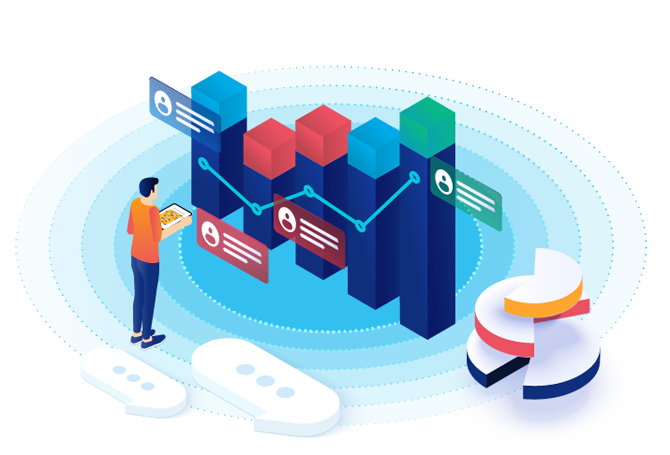Trend analysis is a powerful tool used across various disciplines to identify patterns, forecast future developments, and make informed decisions. Businesses, economists, statisticians, and even meteorologists employ types of trend analysis to understand historical data, recognize trends, and predict future outcomes.
Understanding Types of Trend Analysis

Trend analysis encompasses different methods, each serving specific purposes. The primary types of trend analysis include Time-Series Analysis, Comparative Analysis, and Cross-Sectional Analysis.
Time-Series Analysis Explained
Time-series analysis involves examining data collected at successive points in time. It helps in understanding how a variable changes over time and identifying recurring patterns or trends.
1. Definition and Purpose
The primary goal of Time-Series Analysis is to forecast future values based on historical data. It aids in detecting seasonality, cyclical patterns, and long-term trends, enabling organizations to make proactive decisions.
2. Applications in Various Fields
Time-series analysis finds applications in various fields such as finance, economics, weather forecasting, and sales forecasting. For instance, financial analysts use it to predict stock prices, while meteorologists utilize it to forecast weather patterns.
Comparative Analysis Explained
Comparative Analysis involves comparing data from different periods, entities, or groups to identify similarities, differences, and trends.
1. Definition and Purpose
The purpose of Comparative Analysis is to understand the relative performance of entities or groups over time. It helps in benchmarking, performance evaluation, and identifying areas for improvement.
2. Examples of Comparative Analysis
In business, Comparative Analysis is used to compare sales performance across regions, assess marketing strategies, or evaluate product performance against competitors.
Cross-Sectional Analysis Explained
Cross-sectional analysis involves analyzing data from multiple entities or groups at a specific point in time.
1. Definition and Purpose
Cross-sectional analysis helps in understanding relationships between different variables within a given period. It aids in market segmentation, customer profiling, and identifying emerging trends.
2. Implementation in Business and Finance
In business and finance, Cross-Sectional Analysis is used to analyze market trends, customer preferences, and competitor strategies to gain a competitive edge.
Benefits of Trend Analysis
- Informed Decision-Making: Trend analysis provides valuable insights that enable businesses to make informed decisions.
- Risk Management: By anticipating changes and trends, businesses can mitigate risks and capitalize on opportunities.
- Strategic Planning: Trend analysis helps businesses develop long-term strategies and adapt to changing market conditions.
Challenges in Trend Analysis
- Data Quality: Poor data quality can lead to inaccurate analysis and unreliable insights.
- Complexity: Analyzing trends across multiple variables and factors can be complex and challenging.
- Uncertainty: Market trends and consumer behavior are inherently unpredictable, posing challenges for trend analysis.
Case Studies with Record-Breaking Results
To illustrate the transformative power of trend analysis, let’s explore some case studies where companies achieved record-breaking results by leveraging different types of trend analysis.
1. Netflix and Time-Series Analysis in Content Development
Netflix uses time-series analysis to forecast viewer preferences and trends, allowing them to invest in content likely to succeed. By analyzing viewing patterns and seasonality, Netflix identified that thrillers and limited series perform well during certain times of the year. This led them to produce and release popular shows like Stranger Things during peak periods, which contributed to unprecedented viewership and subscriber growth.
2. Coca-Cola’s Comparative Analysis for Regional Performance
Coca-Cola utilizes comparative analysis to monitor and evaluate sales performance across different regions and demographic groups. When the brand noticed a decline in sugary beverage sales in health-conscious regions, they doubled down on marketing low-sugar alternatives and introduced innovative flavors. This approach not only bolstered sales in these regions but also set a new record for customer engagement with healthier product options.
3. Cross-Sectional Analysis by Airbnb for Market Segmentation
Airbnb used cross-sectional analysis to understand customer demographics and preferences in different markets. By examining data from various customer segments at a single point in time, they recognized a demand for unique accommodations, such as cabins and yurts, among millennials. This insight allowed them to strategically market these options, resulting in a record-breaking number of bookings from younger travelers looking for unconventional stays.
Influencer Quotes and Tweets
Influencer Quotes:
“Trend analysis is the compass that allows businesses to navigate changing markets and stay ahead of the curve.” — Bernard Marr, Tech and Business Influencer
“Successful companies don’t just react to trends; they use trend analysis to predict and shape them.” — Gary Vaynerchuk, Entrepreneur and Marketing Expert
Twitter Insights:
@AnandWrites: “Time-series analysis isn’t just for finance! From predicting pandemics to optimizing supply chains, it’s shaping industries and keeping data-driven companies one step ahead. 📈 #TrendAnalysis #DataScience”
@MindTheProduct: “Comparative analysis is a game-changer in product management. By benchmarking across competitors, you find gaps and opportunities in the market you didn’t know existed! #TrendAnalysis #ProductManagement”
@TheMarketingDiva: “Cross-sectional analysis is like getting a snapshot of your market at any moment. Use it to tailor your strategy to what your customers want NOW! #MarketingTips #TrendAnalysis”
By integrating data-driven trend analysis and learning from these case studies, businesses can uncover insights that fuel growth and innovation, turning patterns into possibilities.
Conclusion
In conclusion, trend analysis is a powerful tool that enables businesses to gain valuable insights, anticipate changes, and make informed decisions. By understanding the various types of trend analysis and employing the right methods and tools, organizations can stay competitive in today’s dynamic marketplace.
For businesses looking to leverage trend analysis effectively, consider requesting a demo from AIM Technologies today!
FAQs
What is the difference between time series analysis and comparative analysis?
- Time series analysis focuses on studying data over successive intervals of time, while comparative analysis involves comparing data from different periods or entities.
How can businesses overcome challenges in trend analysis?
- Businesses can overcome challenges in trend analysis by investing in data quality assurance, leveraging advanced analytics tools, and staying agile in their decision-making processes.
What role does trend analysis play in strategic planning?
- Trend analysis helps businesses develop long-term strategies, anticipate changes in the market, and identify growth opportunities.
Can trend analysis predict future outcomes accurately?
- While trend analysis provides valuable insights, predicting future outcomes with certainty is challenging due to the inherent uncertainty in market dynamics and consumer behavior.
How can businesses benefit from cross-sectional analysis?
- Cross-sectional analysis helps businesses identify trends across different market segments, customer demographics, or geographic regions, enabling targeted marketing strategies and tailored product offerings.




